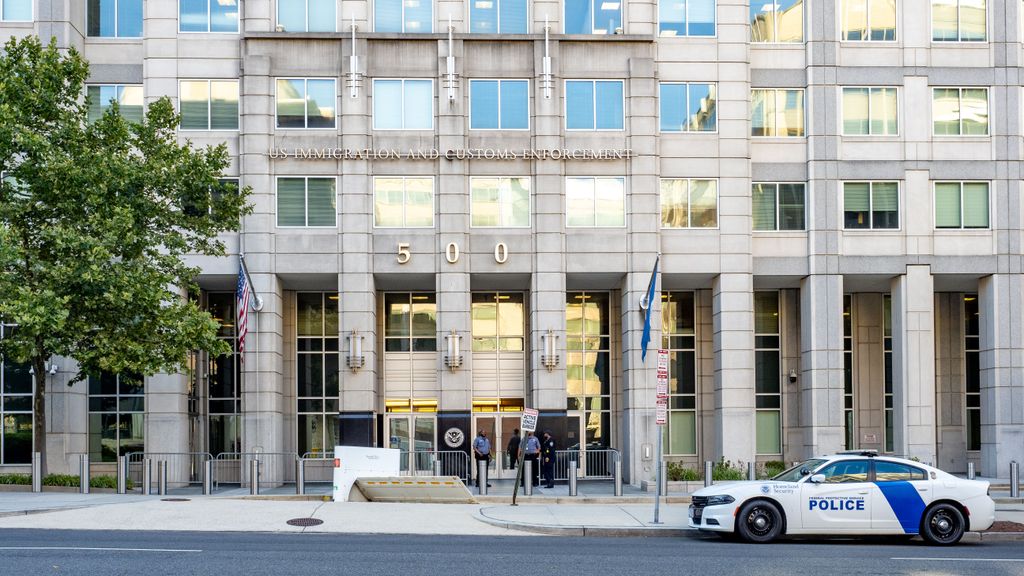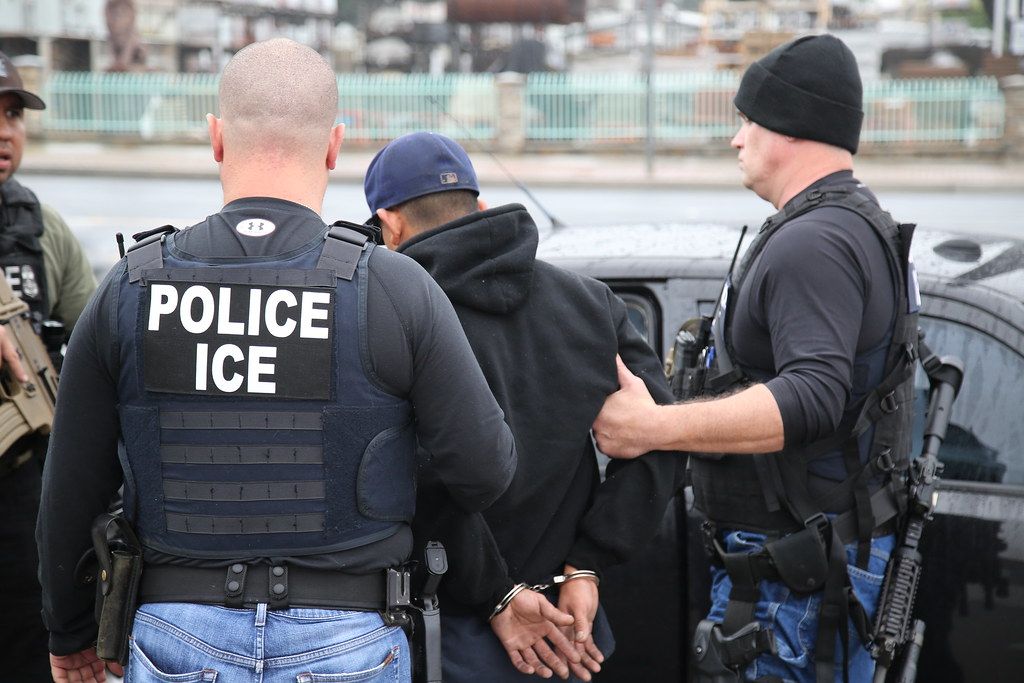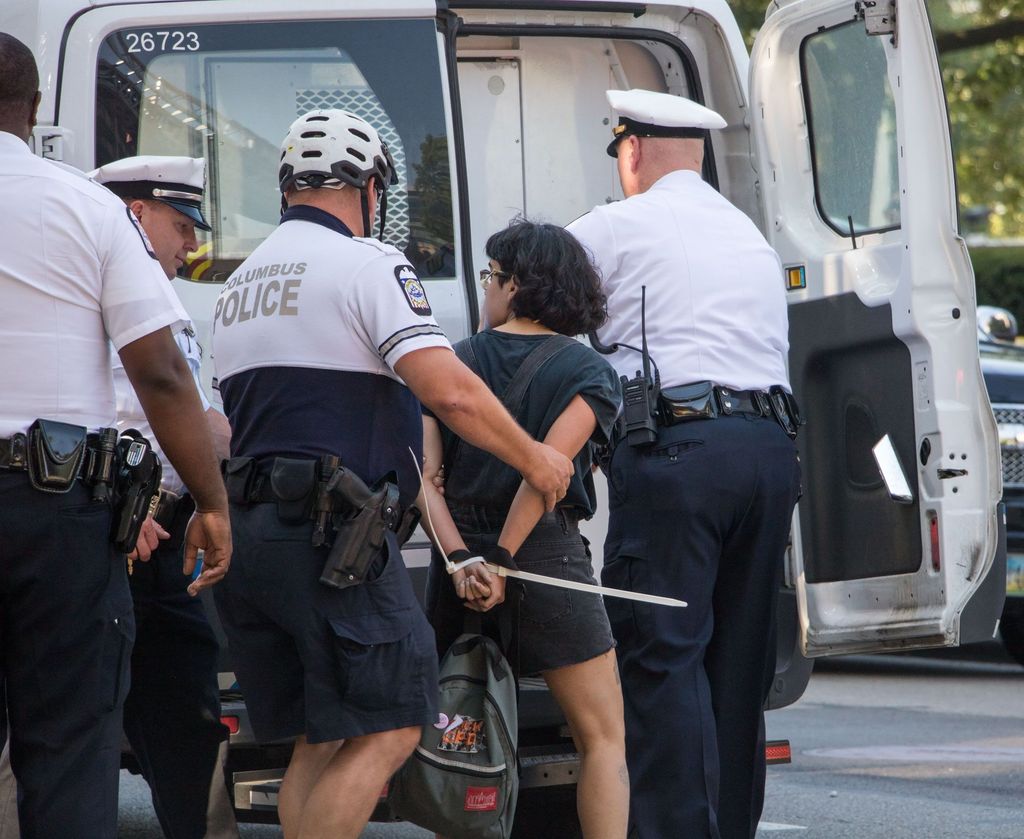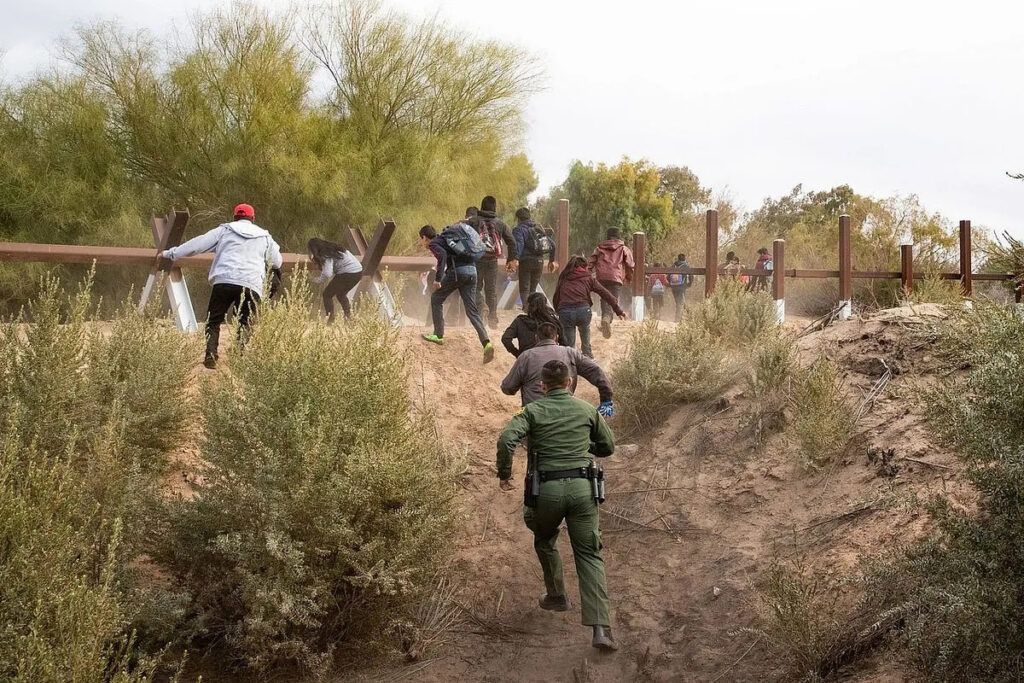
Across the vast expanse of the United States, a quiet yet profound transformation is underway in the realm of immigration enforcement. Data reveals a stark and increasingly pronounced split in the operational approaches of Immigration and Customs Enforcement (ICE) agents, depending on whether they are in states that lean Republican or those that favor Democrats.
This evolving dichotomy has given rise to what experts describe as a “patchwork system,” resulting in profoundly “divergent outcomes based on where people live” for immigrants and their families. It is a nuanced and complex narrative, woven from differing local laws, federal directives, and community responses that shape daily lives.
A comprehensive analysis of ICE data, conducted by CNN, sheds light on this critical divergence. Since President Donald Trump assumed office, the agency’s arrest patterns have demonstrated a clear geographical preference, a trend that has only intensified in the past year.

In states that cast their votes for President Donald Trump, ICE agents are considerably more likely to apprehend immigrants already in the custody of prisons and jails. This tactic accounts for 59% of arrests in these so – called “red states,” reflecting a profound reliance on the existing correctional infrastructure.
Conversely, in states with a Democratic lean, ICE’s approach shifts dramatically. Here, agents are frequently observed conducting arrests in public spaces—on streets, at worksites, or during large – scale roundups. A significant 70% of arrests in these “blue states” occur within the community.
Adding another layer to this intricate scenario, a majority of those apprehended in blue states, particularly in community settings, do not have a criminal record. This stands in stark contrast to red states, where 41% of those arrested had a prior criminal conviction, compared to 36% in states won by Democratic presidential nominee Kamala Harris.
While the overall number of immigrants arrested is higher in red states, both within the community and, notably, within prisons and jails, the method of apprehension remains the critical differentiating factor. This partisan gap, though present before Trump’s second term, has undeniably widened since the previous year.

The Trump administration readily acknowledges these differing tactics, attributing them directly to the presence of “sanctuary policies” in many states and large cities controlled by Democrats. These policies, the administration argues, often restrict prisons and jails from cooperating fully with ICE, preventing local authorities from detaining immigrants solely based on ICE orders.
As Tom Homan, the Trump border czar, pointedly told reporters last month, “Sanctuary cities are going to receive exactly what they do not want: more agents in the communities and more worksite enforcement.” He emphasized the rationale: “Why is that? Because they will not allow one agent to arrest one alleged criminal in a jail.”
Todd Lyons, who served as the head of the agency’s regional office in Massachusetts until March and is now the acting ICE director, echoed this sentiment. He described the concentrated focus on community arrests in his home state as a direct response to sanctuary policies, framing it as a necessity.
Read more about: Federal Control Looms: Trump Renews D.C. Takeover Threat After Assault on Former Government Efficiency Worker

“If sanctuary cities were to change their policies and transfer these violent criminal aliens to our custody, rather than releasing them into the public, we would not have to conduct operations in the communities in this manner,” Lyons stated at a press conference in June, articulating the administration’s perspective.
However, this narrative is vehemently contested by advocates for immigrant rights. They regard the surge in community arrests—ranging from raids at factories and restaurants to unexpected detentions during routine ICE check – ins—as punitive measures. Their objective, they assert, is to instill fear and deter immigration.
Iván Espinoza – Madrigal, the executive director of Lawyers for Civil Rights, a Boston – based nonprofit, characterized these aggressive tactics as “a deliberate federal strategy to penalize Massachusetts and other immigrant – friendly states for standing up against Trump’s reckless deportation apparatus.” This perspective underscores a deeper, politically charged dimension to the enforcement variations.
Kathleen Bush – Joseph, a lawyer and policy analyst at the Migration Policy Institute, notes that regardless of the underlying causes, the divergent local laws and ICE tactics have undeniably created a “patchwork system” across the United States. This system ensures that immigrants face “really divergent outcomes based on where they live,” underscoring the profound impact of geography on individual fates.
To understand the basis of these observations, it is crucial to delve into the methodology behind CNN’s analysis. The data was acquired through a Freedom of Information Act request by the Deportation Data Project, a research group affiliated with the UC Berkeley School of Law, covering the period from when President Trump took office through late June.
ICE, in its annual reports, categorizes arrests into two primary groups: those conducted within prisons and jails, and “at – large” arrests that occur in the community. Jail and prison arrests typically involve ICE sending a detainer request to correctional officials for undocumented inmates, after which agents arrive to take them into custody before their release.

Community arrests, by contrast, comprise a wide range of operations, from targeted workplace raids to teams actively tracking and apprehending immigrants in public settings. This distinction is crucial for understanding the diverse nature of enforcement actions observed nationwide.
Examining broader trends, during President Joe Biden’s administration in 2024, which declared a priority of arresting and deporting undocumented immigrants with criminal records, approximately 62% of ICE arrests originated from prisons and jails, while 27% were community – based. This presents a stark contrast to Trump’s term thus far, during which arrests overall have increased, and the balance has shifted to 49% in prisons/jails and 44% in the community.
The significant divergence in these percentages between the 31 states won by Donald Trump and the 19 states won by Democratic presidential nominee Kamala Harris—despite having similar total undocumented populations according to 2023 estimates from the Center for Migration Studies—vividly illustrates the differences in policy implementation.
In Trump – voting states, not only is ICE more inclined to arrest immigrants already in custody, but those arrested are also more likely to have a prior record. While 41% of arrests in red states involved a prior criminal conviction, CNN’s analysis of internal ICE data revealed that most convictions are for lower – level offenses such as traffic violations, immigration infractions, and other non – violent charges.
Read more about: Federal Control Looms: Trump Renews D.C. Takeover Threat After Assault on Former Government Efficiency Worker

A key factor contributing to this disparity lies in how states and cities without sanctuary policies respond to ICE detainer requests. In the majority of red states, these detainers are honored, which enables ICE to take custody of thousands of undocumented immigrants directly from local jails or prisons.
Take Mississippi as an example: by the end of May, 87% of immigrants for whom ICE had filed a detainer request were subsequently arrested by the agency in prisons and jails. This demonstrates the high degree of cooperation in states that have explicitly banned the establishment of sanctuary policies.
In stark contrast, many blue states and cities have implemented sanctuary policies that explicitly instruct local officials to decline ICE detainer requests unless they are accompanied by a court warrant. Some jurisdictions, such as Boston, go even further by preventing local police officers from inquiring about immigration status altogether.
New York offers a compelling illustration of this blue – state approach: only 4% of immigrants for whom ICE had requested detainers were ultimately arrested in prisons and jails. This significant disparity compels the Trump administration to adopt an alternative strategy, resulting in a greater reliance on immigration raids and community arrests in such areas.
In Los Angeles, where these raids triggered considerable public unrest earlier in the summer, the Trump administration responded by deploying the National Guard. Subsequently, the administration filed a lawsuit against the city, asserting that its sanctuary policies contributed to a “lawless and unsafe environment,” thereby underscoring the contentious nature of these policies.
Many activists, however, contend that the nature of these blue – state raids, particularly ICE’s active promotion and publicizing of them, serves a purpose that goes beyond merely circumventing sanctuary policies. Kathleen Bush – Joseph noted that these aggressive tactics are “shocking, and they represent such a departure from the norm.”
She further elaborated on a broader intent: “But their intent might be more about deterrence and attempting to dissuade people from coming to the US – Mexico border, as well as trying to induce people to self – deport.” This implies a strategic utilization of enforcement to shape migration patterns and attitudes.

Indeed, the arrest and detention apparatus of ICE appears to be gaining momentum. The recent budget reconciliation bill signed by President Trump allocates billions of dollars in new funding for the agency. Furthermore, a growing number of local and state law enforcement agencies, predominantly in red states, are choosing to participate in an ICE program that enables them to assist in enforcing immigration laws.
This expansion encompasses the addition of 10,000 new ICE agents, funded by the 2025 budget bill, which further intensifies state – specific enforcement efforts. These “287(g) agreements” are contracts that authorize local police to act as ICE agents, detaining and processing immigrants directly from custody. At present, there are 629 active 287(g) agreements across the country.
Florida takes the lead in these agreements, accounting for 43% of all active contracts, followed by Texas at 14% and Georgia at 5%. These partnerships are particularly widespread in states governed by Republican leaders and have facilitated high – profile mass raids, such as Florida’s “Operation Tidal Wave,” which led to 1,120 arrests in early 2025.
Read more about: The Pillars of Justice: Unpacking the Role, Appointments, and Global Traditions of Judges in the Modern Era

President Trump and officials from the Department of Homeland Security (DHS) advocate for these local – federal collaborations, actively encouraging the National Sheriffs’ Association to prompt more departments to participate in the 287(g) program. They characterize these local partnerships as “force multipliers” that substantially enhance their ability to apprehend and remove individuals.
Proponents, including numerous sheriffs in red states, assert that rigorous enforcement is crucial for upholding immigration laws and ensuring community safety. They frequently cite the significant number of arrests made within jails and prisons as evidence of the system’s efficacy and necessity.
However, this approach does not go without criticism. Civil rights organizations and some local police leaders voice profound concerns that aggressive ICE tactics can severely damage the indispensable trust between law enforcement and the communities they serve. They contend that these tactics can give rise to racial profiling, where individuals are targeted on the basis of their appearance or perceived origin, and undermine local democratic control.
Read more about: Federal Control Looms: Trump Renews D.C. Takeover Threat After Assault on Former Government Efficiency Worker

Even certain local police in rural red states have expressed apprehension, citing a deficiency of resources to undertake additional immigration duties and concerns regarding potential backlash from their communities. This underscores the multifarious challenges and diverse perspectives surrounding these enforcement strategies.
The practical ramifications of these divergent policies are evident for immigrants themselves. In red states, individuals are at an elevated risk of arrest after serving sentences for even minor offenses or following detention in local jails for infractions such as traffic violations.
Once in custody, they can be expeditiously transferred to ICE owing to the close collaboration between local police and federal agents, often with restricted recourse. This establishes a direct conduit from local justice systems to federal immigration enforcement.
In blue states, immigrants confront a distinct, yet equally consequential, set of risks. Given that local police often refrain from cooperating with ICE, agents are compelled to locate and apprehend individuals in public spaces. This implies that arrests can transpire unexpectedly at workplaces, on the street, or during large – scale sweeps.
Crucially, these community – based arrests frequently target individuals who possess no criminal history, resulting in highly disruptive and often traumatic experiences. The lack of prior notice and the public nature of these detentions contribute to an intensified sense of fear and uncertainty within immigrant communities.
This rapid surge in arrests has imposed considerable strain on detention centers, particularly in states such as Florida. Human Rights Watch and other advocacy organizations have documented grave issues, encompassing overcrowding, inadequate hygiene, and extended periods of shackling in several Florida facilities. These reports pose critical questions concerning the capacity of ICE to manage the burgeoning detainee population in a safe and humane manner.
Furthermore, the proliferation of “task force” – style 287(g) agreements has resulted in local police functioning as mobile immigration agents, sometimes with inadequate training or oversight. This has heightened concerns regarding potential errors, abuses of power, and violations of individuals’ fundamental rights, presenting a disturbing image of decentralized enforcement.

The expanding disparity in ICE tactics between red and blue states has constituted a noteworthy development since 2024. During the tenures of Presidents Obama and Biden, the federal government deliberately curbed the most aggressive forms of local – federal cooperation. Numerous 287(g) agreements were either terminated or substantially scaled back, and ICE was instructed to prioritize individuals with serious criminal records.
However, since 2024, these restrictions have been systematically reversed. The Trump administration has made it a central tenet to expand ICE’s operational scope, augment its funding, and forge additional 287(g) agreements. As a direct result, the distinctions in immigration enforcement between red and blue states have become markedly more pronounced, with each region pursuing its own unique approach.
This scenario also serves as a battleground for legal challenges. Legal experts and immigrant advocates have raised substantial constitutional concerns regarding certain ICE tactics and the legitimacy of 287(g) agreements. At present, several lawsuits are pending in federal courts, directly contesting the legality and execution of these contentious programs.
Simultaneously, sanctuary jurisdictions persist in their endeavors to devise and implement new policies aimed at shielding their residents from aggressive federal enforcement. These initiatives encompass enacting specific local laws, establishing legal defense funds to support immigrants, and providing training to community members on their rights.
This persistent tug – of – war between federal authority and local governance is set to continue, with both sides making preparations for further legal and political skirmishes. The dynamic interaction between these forces will largely shape the future course of immigration enforcement across the nation.
As the Trump administration clearly articulates its objective of further augmenting ICE’s capacity, it is reasonable to expect even more funding allocations and the establishment of new agreements in the months ahead. This trend suggests the potential for an upsurge in arrests in both red and blue states, as ICE continues to adapt its tactics to the distinct conditions of each locality.
However, the result of the ongoing legal challenges against ICE’s methods could potentially redefine how the agency functions. Should the courts determine that certain tactics or agreements violate constitutional rights, ICE may be forced to substantially modify its approach, heralding a new era of enforcement strategies. For the present, the agency exhibits no signs of slowing down its operations.
Read more about: Federal Control Looms: Trump Renews D.C. Takeover Threat After Assault on Former Government Efficiency Worker

For immigrants and their families traversing this intricate and frequently perilous terrain, taking practical measures assumes paramount importance. It is of utmost significance to be fully apprised of local laws and policies, comprehending whether your city or state functions under a sanctuary policy or a 287(g) agreement, as this will directly impact ICE’s presence and operational tactics in your locality.
Crucially, being cognizant of your rights serves as an invaluable safeguard. Every individual, irrespective of immigration status, is endowed with certain fundamental rights under the U.S. Constitution. Acquiring knowledge of the appropriate actions to take when approached by ICE or local police can make a pivotal difference. Furthermore, if you or a loved one encounters detention, promptly seeking legal aid from a proficient immigration attorney or a reputable advocacy group is of vital importance.
The prevailing divergence in ICE tactics between America’s red and blue states has created a veritable mosaic of enforcement experiences for immigrants across the country. In the deep – red expanse of red states, arrests stemming from jails and prisons have become the entrenched standard, becoming an integral part of the local law – enforcement framework.
Read more about: The Pillars of Justice: Unpacking the Role, Appointments, and Global Traditions of Judges in the Modern Era

Conversely, within the sapphire – hued territories of blue states, community – wide raids and public apprehensions constitute the prevailing strategy, engendering an atmosphere of heightened vigilance and uncertainty. The dramatic augmentation of 287(g) agreements and the injection of additional ICE funding serve as the pivotal forces driving these sweeping changes, casting long shadows over civil liberties, the fragile trust between communities and law enforcement, and indeed, the very future of immigration enforcement itself.
Read more about: Beyond the Headlines: A Comprehensive Look at Key Policy Impacts Shaping America’s Economic and Social Landscape
These ongoing developments, as elucidated by sources such as VisaVerge.com, compellingly underscore the urgent necessity for clear, accessible information, unwavering legal support, and robust community action. Whether these profound trends will persist along their current trajectory or experience a substantial recalibration will hinge on the intricate interplay among future court rulings, momentous political transformations, and the tireless, committed endeavors of advocates and local leaders who champion the rights of the vulnerable. For the time being, immigrants, their families, and the communities that welcome them must stay highly vigilant and be well – prepared for a landscape that is perpetually in a state of flux, a testament to the enduring forces of change shaping the American experience.



